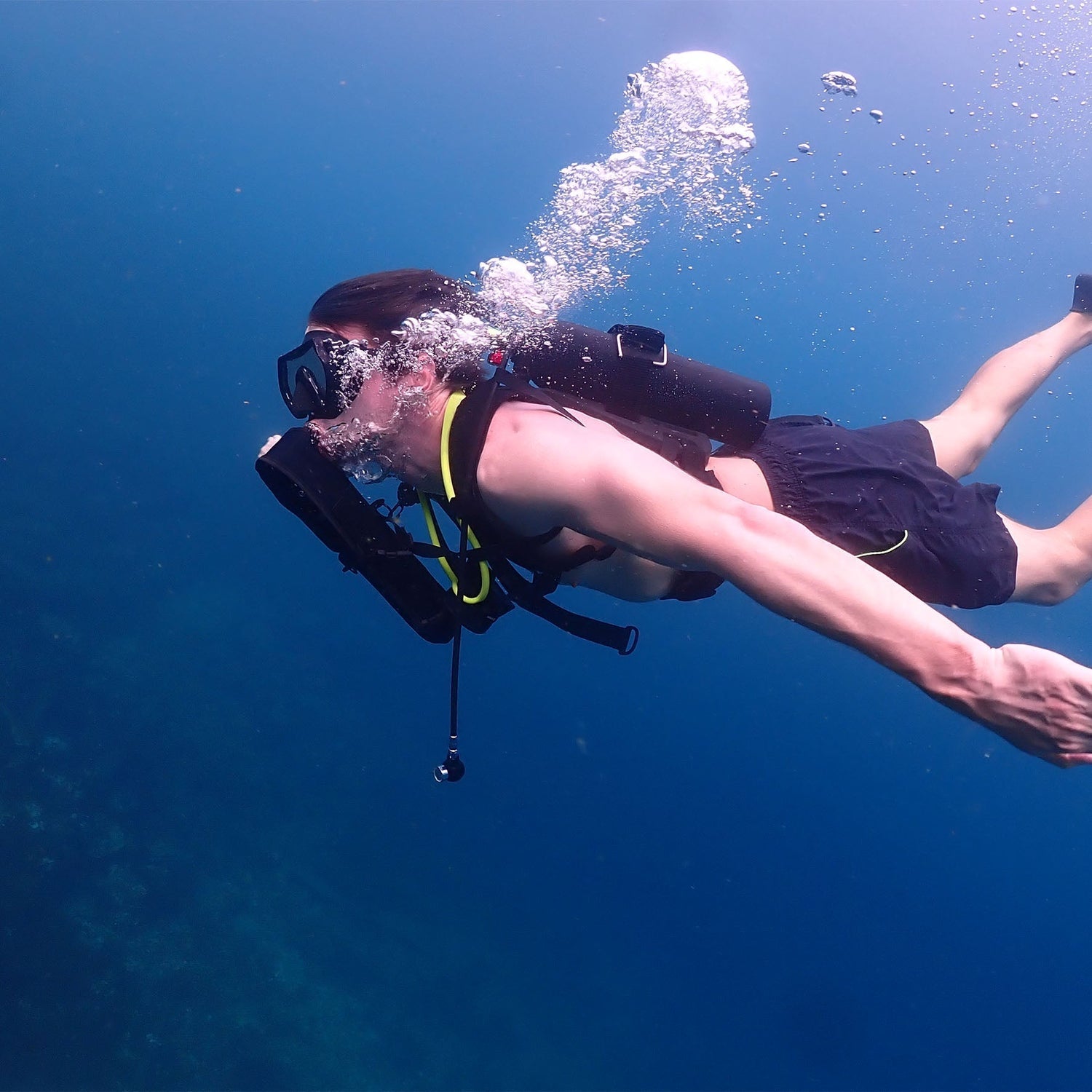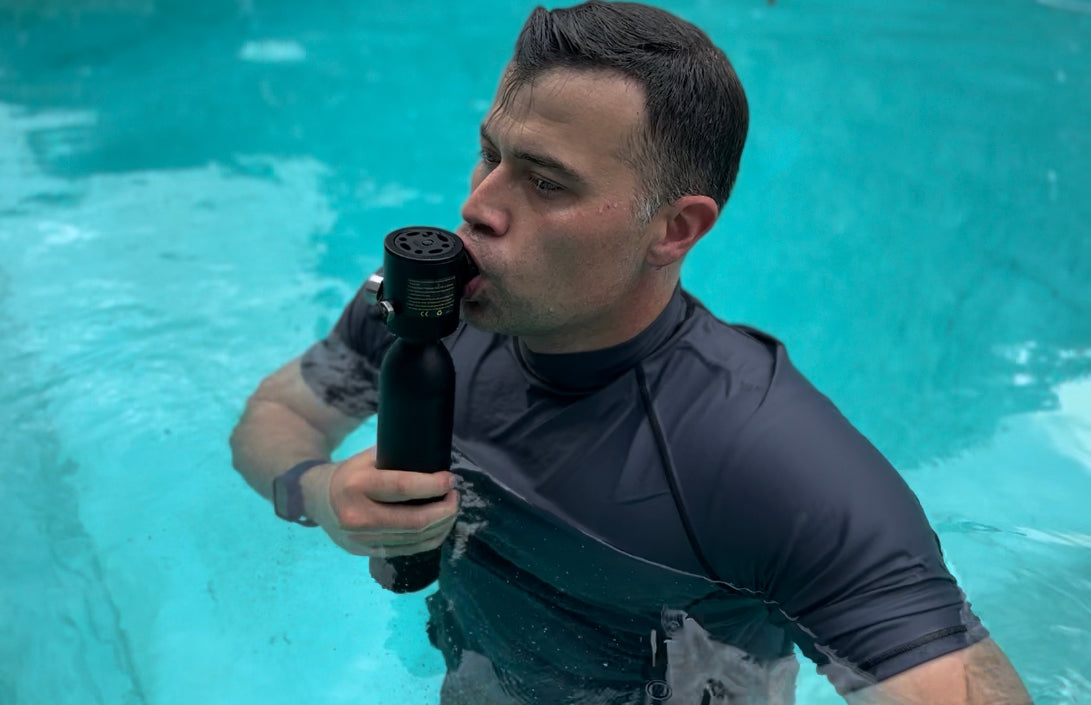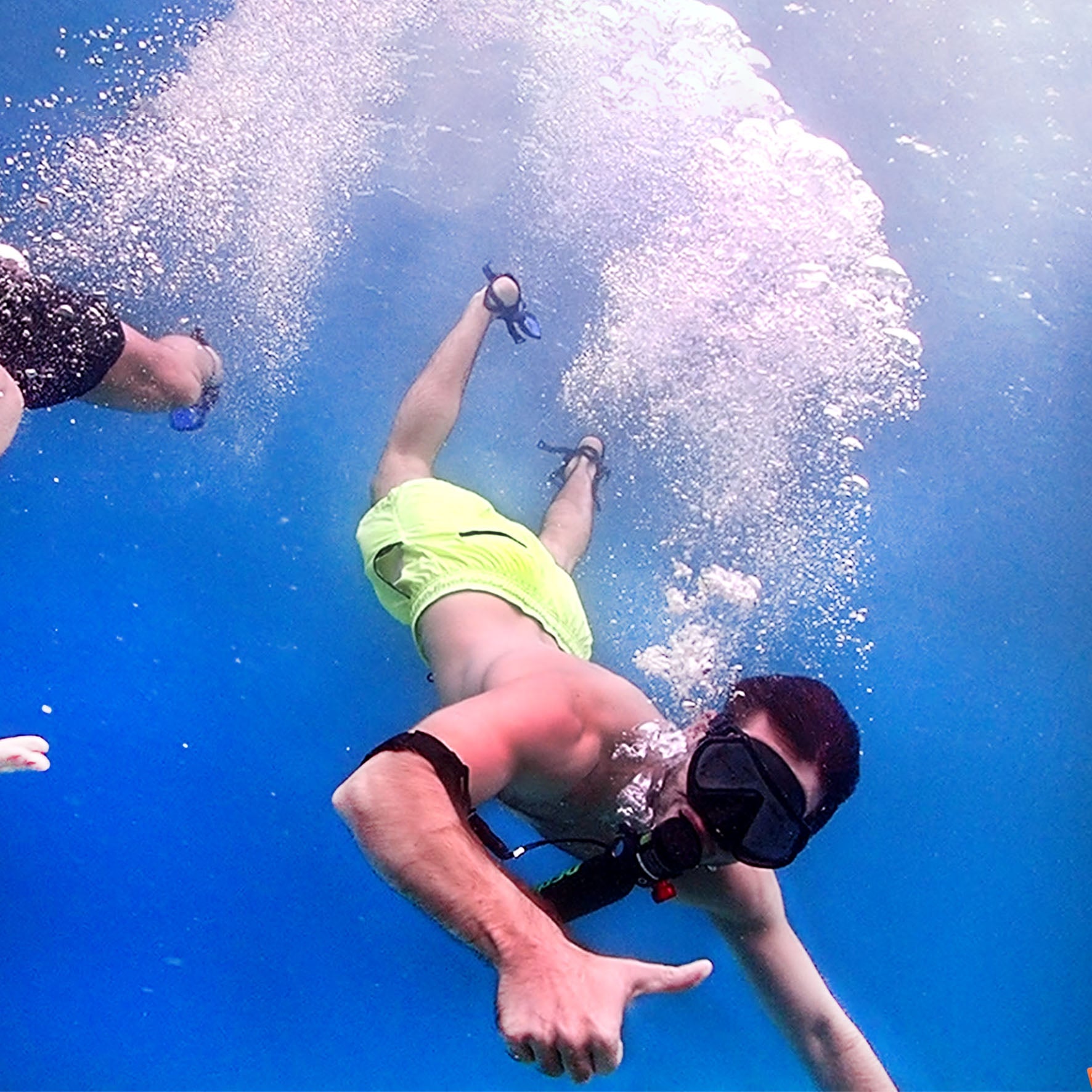Most people assume scuba tanks are filled with pure oxygen, but standard diving tanks actually contain just 21% oxygen—the same as regular air. Using 100% oxygen underwater is dangerous beyond 6 meters (20 feet) due to oxygen toxicity, which can cause seizures. Recreational divers typically use normal air or enriched air nitrox (22-40% oxygen) for longer bottom times. Technical divers may use trimix (oxygen, nitrogen, and helium) for deep dives below 40 meters (130 feet).
What’s Really Inside a Scuba Tank
Most people think scuba tanks are filled with pure oxygen, but standard recreational tanks actually hold regular air—21% oxygen and 79% nitrogen, compressed to 200-300 bar (2,900-4,350 psi). Pure oxygen is rarely used because it becomes toxic below 6 meters (20 feet), risking seizures. Instead, divers use:
Normal air (21% O₂): The cheapest option, costing 5-10 per fill, good for dives up to 40 meters (130 feet).
Nitrox (22-40% O₂): Extends bottom time by reducing nitrogen absorption—e.g., EAN32 (32% O₂) allows ~20% longer dives at 18-30 meters (60-100 feet). Fills cost 10-20, needing special filters to remove moisture.
Trimix (oxygen + nitrogen + helium): Used below 40 meters (130 feet) to prevent narcosis. A typical mix like 18/45 (18% O₂, 45% helium) cuts nitrogen load by 30-50% but costs 50-100 per fill due to helium prices (~0.80-1.20 per liter).
Tank sizes vary:
Aluminum 80 (11L, 207 bar): Weighs 14 kg (31 lbs), holds 2,400L of air, lasts 45-60 mins at 10m.
Steel 12L (232 bar): Holds 2,800L, lasts ~70 mins, but weighs 18 kg (40 lbs).
Key rule: Never use 100% O₂ below 6m—even 40% Nitrox has a max depth of 30m (100 ft) before toxicity risks spike.
1. Standard Air: Cheap, Simple, and Limited
Recreational divers breathe the same air as on land—just compressed. At 200 bar, an 11L tank stores ~2,400L of air, enough for 45-60 mins at 10 meters (33 ft). Deeper dives (e.g., 30m/100ft) cut time to 20-25 mins due to 3x higher air consumption. Cost: 5-10 per fill, with filters removing 99.9% of oil/water.
2. Nitrox: Pay More, Dive Longer
Enriched air (EAN32 or EAN36) reduces nitrogen intake, letting divers stay down 15-30% longer. For example:
At 18m (60ft), no-deco time jumps from 55 mins (air) to 75 mins (EAN32).
O₂ exposure limits: EAN32 maxes at 35m (115ft), EAN36 at 29m (95ft).
But Nitrox isn’t free—fills cost 15-25, and tanks must be O₂-cleaned (contamination <0.1%) to avoid fire risks.
3. Trimix: For the Depths, Not Your Wallet
Below 40m (130ft), nitrogen narcosis ("rapture of the deep") kicks in. Trimix replaces nitrogen with helium:
18/45 trimix (18% O₂, 45% He): Safe to 60m (200ft), but helium costs 1 per liter—a fill runs 80+.
Hypoxic mixes (10% O₂): For 100m+ dives, but require dual tanks (one for ascent).
4. Pure Oxygen? Only for Shallow Medical Dives
100% O₂ is used above 6m (20ft) in:
Military rebreathers (2-3 hour runtime).
Decompression stops (5m/15ft for 3-5 mins).
Below 6m, the CNS toxicity limit hits 45 mins at 1.4 bar partial pressure—exceeding this risks convulsions.
5. Tank Materials Matter
Aluminum (80 cu ft): 250-400, lasts ~10,000 fills, but floats when empty.
Steel (12L): 500-800, lasts 20+ years, but corrodes if not rinsed.
Tip: Always analyze your gas—a $200 O₂ meter beats an oxygen seizure at 30 meters.

Why Pure Oxygen Isn’t Safe for Diving
At just 6 meters (20 feet), 100% oxygen reaches a partial pressure of 1.6 bar, crossing the CNS (Central Nervous System) toxicity threshold. Beyond this depth, the risk of seizures jumps from <1% to over 50% within 30 minutes—with zero warning signs. That’s why recreational divers never use pure O₂, and even technical divers limit exposure:
- Military rebreathers use 100% O₂ but only above 6m (20ft), with strict 45-minute max exposure at shallow depths.
- Decompression stops at 5m (15ft) sometimes use pure O₂ to speed up nitrogen off-gassing, but divers monitor time to stay under 1.4 bar partial pressure (safe limit).
- Commercial saturation divers avoid it entirely—helium-based mixes (like hydreliox) are safer below 100m (330ft).
The deeper you go, the worse it gets:
- At 10m (33ft), 100% O₂ hits 2.0 bar partial pressure, cutting safe exposure to just 15 minutes.
- At 20m (66ft), it’s 3.0 bar, causing convulsions in <5 mins for most divers.
Even 40% Nitrox (EAN40) has depth limits—25m (82ft)—before O₂ toxicity risks spike. Bottom line: Pure O₂ is for hospitals, not scuba tanks.
1. Oxygen Toxicity: The Silent Killer
Your brain and lungs can’t handle high-pressure O₂. Two main dangers:
CNS Toxicity: At >1.4 bar partial pressure, oxygen disrupts nerve signals. Symptoms? Tunnel vision, nausea, then seizures—with no time to surface.
Probability: 5% at 1.6 bar, 50% at 2.0 bar (per US Navy tables).
Survival rate if seizure hits at 30m: <20% (due to drowning risk).
Pulmonary Toxicity: Breathing 100% O₂ for >12 hours at surface pressure causes lung damage. At 10m, that drops to 4 hours.
2. Why Depth = Danger
Partial pressure scales with depth:
Surface (1 atm): 100% O₂ = 1.0 bar PP (safe indefinitely).
6m (20ft): 1.6 bar PP (max 45 mins).
10m (33ft): 2.0 bar PP (max 15 mins).
20m (66ft): 3.0 bar PP (seizures in 2-5 mins).
Real-world example: A 2021 incident in Florida saw a diver using 80% O₂ at 15m (49ft). He convulsed at 12 minutes, drowning before buddies could react.
3. Military vs. Recreational Use
Navy SEALs use closed-circuit rebreathers with 100% O₂, but:
Max operating depth: 6m (20ft).
Mission time: <3 hours (to avoid lung damage).
Recreational divers stick to 21-40% O₂ mixes, with strict depth limits:
EAN32: Max 35m (115ft).
EAN40: Max 25m (82ft).
4. The Helium Solution
For deep dives (40m+), helium dilutes oxygen to safe levels:
Trimix 18/45: 18% O₂, 45% He, 37% N₂.
Safe to 60m (200ft) (PPO₂ = 1.08 bar).
Cost: 80-120 per fill (helium is $1.20/L).
5. Testing & Safety Gear
O₂ analyzers (200-500) check tank mixes before every dive.
Dive computers track PPO₂ in real-time, alarming if >1.4 bar.
Rule: If you’re not in a shallow medical or military dive, 100% O₂ is a death wish. Stick to air or Nitrox—your brain will thank you.
The Standard Mix
When you grab a rental tank at a dive shop, 99% of the time it’s filled with plain old air—21% oxygen and 79% nitrogen, compressed to 200-232 bar (2,900-3,400 psi). This isn’t just the cheapest option (5-10 per fill), it’s also the most versatile for recreational diving.
At 10m (33ft), a standard 11L aluminum tank holds 2,400L of air, lasting 45-60 minutes for an average diver breathing 20L per minute.
At 30m (100ft), the same tank drains 3x faster (due to 4x pressure), cutting dive time to 20-25 minutes.
No special training needed—unlike Nitrox or trimix, normal air has no depth limits beyond standard no-decompression rules (40m/130ft max for recreational divers).
But it’s not perfect:
Nitrogen narcosis starts creeping in past 30m (100ft), making divers feel drunk (hence the "martini rule": every 10m = one drink).
Decompression stops add time: a 25m (82ft) dive for 30 mins requires 3-5 mins at 5m (15ft) to off-gas nitrogen safely.
1. The Physics of Breathing Compressed Air
Surface air: 21% O₂, 79% N₂, plus trace gases (argon, CO₂).
At depth, partial pressures multiply:
10m (2 atm): O₂ = 0.42 bar, N₂ = 1.58 bar.
30m (4 atm): O₂ = 0.84 bar, N₂ = 3.16 bar (narcosis threshold).
Real-world impact:
A diver at 30m inhales 4x more nitrogen per breath than at the surface, saturating tissues 2x faster.
2. Tank Economics: Why Air Wins
Cost:
Air fill: 5-10 (vs. 15-25 for Nitrox).
Tank rental: 10-20/day (aluminum 80).
Efficiency:
11L tank (80 cu ft): 2,400L of air, weighs 14 kg (31 lbs) full.
Steel 12L: Holds 2,800L, lasts 10-15% longer, but costs 500+ vs. 300 for aluminum.
3. Limits & Risks
No-deco time (recreational limits):
18m (60ft): 56 mins on air.
30m (100ft): 20 mins (with 5-min safety stop).
Narcosis:
30m: 10-20% of divers feel mild impairment.
40m: 50% report confusion (like 0.08% blood alcohol).
4. When to Upgrade from Air
Longer bottom time: Nitrox (EAN32) adds 15-30% at 18-30m.
Deeper dives: Trimix cuts narcosis below 40m (but costs $80+ per fill).
5. Maintenance Matters
Air purity: Must meet ISO 8573-1 Class 1 (oil/water <0.01 mg/m³).
Filter lifespan: 500-1,000 fills ($50 replacement).
Pro Tip: If you’re diving <30m and not pushing no-deco limits, save cash—air does the job.
Special Mixes for Technical Diving
When divers go deeper than 40 meters (130 feet) or stay down longer than 1 hour, normal air becomes a liability. That’s where trimix, heliox, and hydreliox come in—custom gas blends that swap out dangerous nitrogen for helium and fine-tune oxygen levels. But these mixes aren’t cheap:
Trimix 18/45 (18% O₂, 45% helium, 37% N₂) costs 80-120 per fill, mostly due to helium prices (1.20-1.50 per liter).
Heliox (10% O₂, 90% He) is used below 100m (330ft), where nitrogen narcosis feels like being blackout drunk. A single fill runs $150+.
Hydreliox (helium + hydrogen) is for extreme depths (300m+)—research divers use it, but it’s $300+ per fill and requires 3+ tanks for a single dive.
The benefits?
At 60m (200ft), trimix cuts nitrogen narcosis by 50-70% compared to air.
Dive times extend—a 30m (100ft) wreck dive on trimix can last 60+ mins vs. 25 mins on air.
Decompression is faster: Helium off-gasses 2.6x quicker than nitrogen.
But there’s a catch:
Oxygen toxicity still applies—even with trimix, O₂ partial pressure must stay <1.4 bar.
Hypoxia risk: Below 6m (20ft), mixes with <16% O₂ can cause blackouts.
Bottom line: Tech diving gases are like F1 fuel—high-performance, expensive, and deadly if used wrong.
1. Trimix: The Gold Standard for Deep Dives
Typical blends:
18/45: For 40-60m (130-200ft), keeps O₂ at 0.18-0.21 bar at max depth.
10/70: For 80-100m (260-330ft), O₂ as low as 0.10 bar to avoid toxicity.
Cost breakdown:
Helium (45% of mix): 50-70 per fill.
Oxygen (18%): 5-10.
Nitrogen (37%): Basically free.
2. Heliox: When Nitrogen is the Enemy
Used for 100-150m (330-500ft) dives, where nitrogen narcosis is 100% debilitating.
Cons:
Voice distortion (sounds like Donald Duck).
Hypothermia risk: Helium conducts heat 6x faster than air.
150-200 per fill—most divers recycle gas to save costs.
3. Hydreliox: The Deepest of the Deep
Hydrogen replaces some helium below 200m (650ft) because helium gets too dense to breathe.
Pros:
Lighter gas = easier breathing at 300m+.
30% cheaper than pure heliox (hydrogen costs 0.30/L vs. helium’s 1.50/L).
Cons:
Highly flammable—one spark and you’re a fireball.
Requires specialized training (fewer than 1,000 divers worldwide are certified).
4. Gas Switching: The Art of Survival
Travel gas: Air or Nitrox for 0-40m.
Bottom gas: Trimix for 40-100m.
Deco gas: Pure O₂ at 6m (20ft) to speed up off-gassing.
Average tech dive uses 3-4 tanks, costing 200-500 in gas alone.
5. The Math Behind Safe Diving
O₂ limits:
1.4 bar max during dive.
1.6 bar max during deco (short bursts).
Helium limits:
>80% He causes HPNS (High-Pressure Nervous Syndrome)—tremors, nausea.
Solution: Keep He <70% for dives <150m.
Pro Tip: If you’re not diving below 40m, stick to Nitrox. Tech gases are for pros with budgets to match
How Divers Choose the Right Gas
Recreational dives (0-30m/100ft): 80% use air (5/fill) or Nitrox (15-25/fill). EAN32 adds 15-30% bottom time at 18m, but pushes max depth to 35m (vs. 40m on air).
Technical dives (30-60m/100-200ft): Trimix 18/45 (80-120/fill) cuts narcosis by 50% but requires 3+ tanks—budget 300+ per dive.
Extreme depths (60m+): Heliox (150-200/fill) or hydreliox (300+), with 5:1 gas planning (5L breathed for every 1m depth).
Critical rules:
O₂ partial pressure must stay <1.4 bar during dive, <1.6 bar during deco.
Helium % scales with depth—10/70 trimix at 100m, but 21/35 at 40m.
Never breathe <16% O₂ above 6m—risk of blackout in <2 mins.
Cost vs. benefit:
$20 Nitrox fill buys 20 extra mins at 20m.
$100 trimix fill lets you dive to 60m safely—but adds 60 mins deco.
Bottom line: Gas choice is math, not guesswork.
1. Depth Dictates Everything
0-30m:
Air: Max 40m depth, $5/fill.
Nitrox 32: Max 35m, but 56min no-deco at 18m (vs. 45min on air).
30-60m:
Trimix 21/35: $60/fill, O₂=0.21 bar at 40m.
Trimix 18/45: $100/fill, O₂=0.18 bar at 60m.
60m+:
Heliox 10/90: $180/fill, but voice unusable and 5hrs deco at 100m.
2. Time = Gas Volume × Consumption
At 30m:
Air consumption: 40L/min (vs. 20L/min at surface).
11L tank lasts 25 mins (single tank).
Solution:
Double 12L tanks: 80 mins at 30m, but 24kg/53lbs of gear.
Rebreathers: 3hrs+ on 2L O₂, but cost $5,000+.
3. Budgeting for Gas
Recreational:
10 dives on air: $50.
10 dives on Nitrox: $200.
Technical:
1 deep trimix dive: 100 gas + 200 deco gases.
Yearly cost (50 dives): $8,000+.
4. Safety Checks You Can’t Skip
Analyze gas before diving:
O₂% error >1% = risk of toxicity.
Helium % variance >5% = recalculate deco.
Monitor PPO₂ in real-time:
Dive computers alarm at 1.4 bar.
Manual checks every 10m.
5. When to Break the Rules
Shallow caves: Use EAN32 for 90min+ dives despite 35m limit.
Deep wrecks: Heliox below 80m, even with $500 gas cost.
Pro Tip: Plan gas first, dive second. A 10 calculator beats a 50,000 chamber ride.





Leave a comment
All comments are moderated before being published.
This site is protected by hCaptcha and the hCaptcha Privacy Policy and Terms of Service apply.